科学技術分野 ― 建設工事(旧赤プリ)
出典: 日本経済新聞電子版 記事 2013年11月27日掲載
<原文>
PDFファイルはこちらから→Click here for a PDF file.
黄色の部分については、この下に掲載してある<訳者からの連絡事項>をご参照下さい。
各画像の下に記載してあるFigure 1 〜17は、原文にはありません。
じわりと毎秒1ミリ、赤プリ旧館をまるごと動かす
驚異の工事現場シリーズ
2013/11/27 7:00
東京都千代田区にある旧グランドプリンスホテル赤坂の跡地で超高層ビル2棟の新築工事を進める西武プロパティーズ(埼玉県所沢市)は、敷地内で保存する「旧館」の曳き家(ひきや)工事を11月18日に公開した。曳き家とは、建物を解体せずにそのままの状態で移動させること。旧館の移動距離は44mで、施工は大成建設が手掛けている。
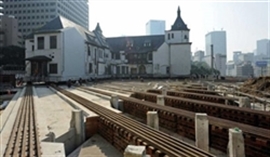
北側から見る。旧館は写真手前から奥に向かって動いた。建物が元あった場所には切断した柱などが残る。11月18日に撮影(写真:日経アーキテクチュア、以下同じ) Figure 1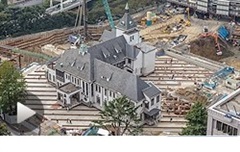
ゆっくりとゆっくりと動く「赤プリ」旧館。保存のための移設作業を公開(18日) Figure 2
旧館は旧朝鮮王室の邸宅として1930年に完成した鉄筋コンクリート造、地上2階建ての建物。宮内省内匠(たくみ)寮(現在の宮内庁管理部)が設計して、清水組(現在の清水建設)が施工した。
旧館は戦後、西武鉄道の所有となり、55年に客室数31室の赤坂プリンスホテル(通称、赤プリ)として開業した。83年に丹下健三氏の設計で40階建ての「新館」が開業してからは、婚礼施設やレストラン、バーなどとして使われてきた。
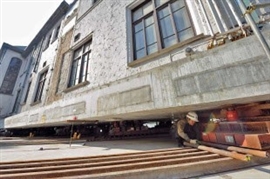
写真の左手前に向かって動く旧館。床下では作業員が建物を支える「ころ棒」の盛り替えや微調整などに追われる Figure 3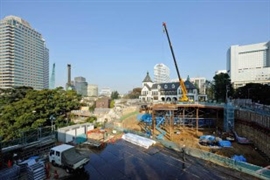
南側から見た現場の様子。写真中央が旧館。手前では住宅棟の山留め工事や掘削工事が進む Figure 4
西武プロパティーズは2011年3月にホテルの営業を終了。新館は大成建設・西武建設JV(共同企業体)が「テコレップシステム」と呼ぶ騒音や粉じんを抑える工法を使って、13年7月までに解体した。解体工事中に、ホテルが徐々に低くなっていく様子が話題を呼んだ。
跡地には地下2階、地上36階建てで高さ180mのオフィス・ホテル棟と、地上24階建てで高さ90mの住宅棟を建てる。総事業費は約980億円で、16年夏ごろの開業を目指す。
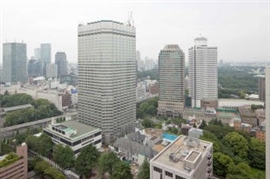
敷地の北東側から12年7月に撮影した現場の全景。写真中央左に見えるのが40階建ての新館(写真:西武プロパティーズ、以下同じ) Figure 5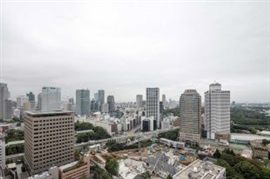
同じ位置から13年10月に撮影したもの。新館などは解体されて姿を消した Figure 6
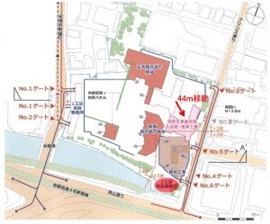
工事現況図。旧館(旧李王家東京邸)は11月19日までに、南東方向に44m動かす1回目の曳き家を終えた。図中の1工区は新築するオフィス・ホテル棟、2工区は住宅棟の現場をそれぞれ示す(資料:西武プロパティーズ) Figure 7
旧館は11年に東京都の有形文化財として指定された。「貴重な文化財を保存して、建て替え計画のシンボルにしたい」。西武プロパティーズ都市開発部の妹尾寛仁ジェネラルマネージャーはこう話す。
ただし、保存後の旧館の利用方法は現時点で明らかにしていない。妹尾ジェネラルマネージャーは「関係官庁と協議して、多くの人に利用してもらえる施設にしたい」と述べるにとどめた。
■移設中に地下躯体を構築
曳き家は2段階に分けて施工する。13年11月に1回目の曳き家を実施。元の場所から南東方向に44m動かして仮置きする。
仮置きする間、旧館があった場所の地下にオフィス・ホテル棟の駐車場やバス乗り場、タクシー乗り場などをつくる。地上部に床スラブを打設した後、逆打ち工法で掘削を進める。旧館は14年8月に2回目の曳き家を実施して、ほぼ元の位置まで戻す。
「駐車場などの基盤施設を地下に埋設することで、地上部を緑化する計画だ」と、設計・監理を担う日建設計PMO部の松崎愛彦氏は説明する。
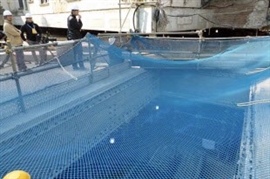
敷地の一部には地下躯体の床スラブを先行して設けた(写真:日経アーキテクチュア、以下同じ) Figure 8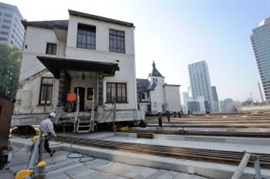
曳き家中の旧館を北側から見る。建物は垂直方向に22cmジャッキアップしている Figure 9
旧館を曳き家せず、元の位置に残したまま直下で、駐車場などの躯体工事(主要構造部分を作る工事)を進める案も検討した。しかし、建物の仮支えなどが複雑になる。「費用と工期の両方を考えると、旧館をいったん曳き家した方が有利だった」(松崎氏)
■毎秒0.5〜1mmの速さでそろりと移動
1回目の曳き家は11月11日に開始。11月19日までの休工日を除く実質8日間で44m移動した。建物の総重量は5000t。油圧式の推進ジャッキで総重量の3〜4%に相当する200t弱の水平力を加えて、毎秒0.5〜1mmの速さで動かした。
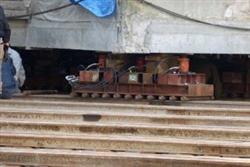
レール上にころ棒を並べた移動台車。1台当たりで平均50t強の建物重量を支える Figure 10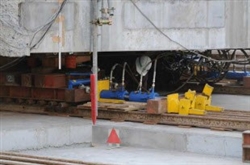
移動台車を押す推進ジャッキ。ストロークが200mmのジャッキを2台つなげた Figure 11
「見ていても動いていることが分からないくらいのゆっくりとしたスピードだ。ジャッキの油圧や建物の変位量を一元管理して、不具合が起こらないよう慎重に作業している」と、大成建設の小倉学作業所長は言う。
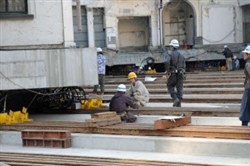
推進ジャッキは18列あるレールのうち、15列のレールの後端部に設けた Figure 12
曳き家に先立って、大成建設は12年7月以降、旧館1階の床や梁の下に、厚さ75cmほどのプレストレスト・コンクリート(鉄筋とは異なる特殊な鋼材を入れることで、引張力への耐性を高めたコンクリート)製の「マットスラブ」と呼ぶ補強床を順次構築していった。マットスラブの下に仮受けジャッキを据え付け、建物の重量を受け替えた後、既存の柱をワイヤソーで切断した。
その後、地上部にレールを敷設して、直径60mmのころ棒を介した計95台の移動台車に建物を載せ、後端部から推進ジャッキで水平方向に押した。推進ジャッキの数は15台。1回のストロークで建物を約350mmずつ動かした。
「ジャッキによる押し出し作業を1日に17〜20回繰り返して、建物を1日当たりおよそ6mずつ移動させた」(小倉所長)。建物の移動中は、30人ほどの作業員を床下や周囲に配置。移動に合わせ、ころ棒を盛り替えたり、位置を微調整したりして、建物がスムーズに動くように気を配った。
■旧館はチューダー様式の外観
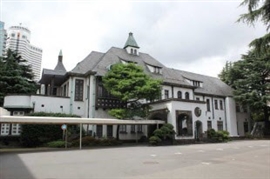
曳き家工事前の旧館の外観(写真:西武プロパティーズ、以下同じ) Figure 13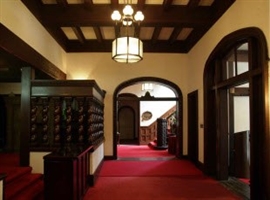
旧館1階の広間 Figure 14
旧館は、旧李王家東京邸とも呼ばれ、外観は英国のチューダー様式を基調とする。車寄せの開口部や階段室にあるステンドグラスの窓上部に、半円を少し押し潰したような形の特徴的なアーチが見られる。木造の小屋組みに支えられた屋根はスレートぶきで、急勾配の大きな寄棟に屋根窓や塔屋を組み合わている。
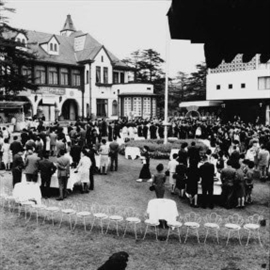
旧赤坂プリンスホテルで開かれたガーデンパーティーの様子。65年に撮影 Figure 15
一方、内装はねじり柱や網代(あじろ)天井など、多様なデザインが混在する。1階に来客用の広間や大食堂を配置。2階には寝室などのプライベートな部屋が設けられていた。
■創建時の姿を復元
2段階の曳き家工事を終えた旧館は、後年に増築されていた2階の一部を撤去してベランダを設けるなど、創建時の姿を復元する。基礎部分の免震化も計画している。
さらに、建物の北西側を新たに増築して、再活用するために必要な諸室を集約する。西武プロパティーズでは「旧皇族建築として当時の面影を残しつつ、建物として命ある文化財を目指す」と説明している。
新築する2棟の超高層ビルのうち、オフィス・ホテル棟は鹿島・鉄建・熊谷組JVが施工。現在は、既存の地下躯体を解体しているほか、新築の山留め工事や掘削工事を進めている。
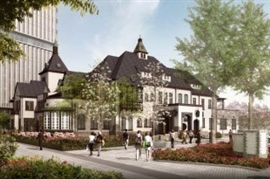
旧館の完成イメージを東側から見る。後年に増築されていた2階北側を一部撤去して、ベランダを復元する(資料:西武プロパティーズ、以下同じ) Figure 16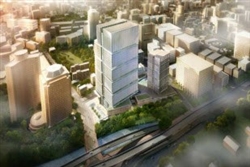
南側から見た敷地全体の完成イメージ。左がオフィス・ホテル棟で、右が住宅棟 Figure 17
鉄骨造の制振構造で、地上1〜4階に商業施設、5〜28階にオフィス、30〜36階にホテルが入る。オフィスは1フロア1000坪超の大きな空間を確保。ホテルは客室数が250室程度で、西武グループのプリンスホテル(東京都豊島区)が旧館とともに運営する。
住宅棟は西武建設・大林組・前田建設工業JVが施工。こちらも現在、山留め工事や掘削工事が進んでいる。建物は鉄筋コンクリート造で免震構造を採用する。フロントコンシェルジュなどのサービスを提供する約130戸の賃貸住宅となる計画だ。
オフィス・ホテル棟と住宅棟の工期は13年1月から16年5月ごろまで。設計・監理は日建設計が担当。外装デザインは米国の設計事務所であるコーン・ペダーセン・フォックス・アソシエーツ(KPF)が手掛けた。
工事概要
名称=旧グランドプリンスホテル赤坂 旧館曳き家工事、工事場所=東京都千代田区紀尾井町1-2、発注者=西武プロパティーズ、設計・監理者=日建設計、施工者=大成建設、工期=2011年9月1日〜14年11月30日、建築面積=約950m2(平方メートル)、延べ面積=約1790m2、階数=地上2階、構造=鉄筋コンクリート造/一部木造
(日経アーキテクチュア 瀬川滋)
<訳文>
PDFファイルはこちらから→Click here for a PDF file.
1 mm per second, slowly but steadily, move the old building of Aka-Puri entirely
Astonishing construction site series
Nov 27 2013 7:00
Seibu Properties (Tokorozawa City, Saitama Prefecture), which is moving ahead with construction of two new high-rise buildings in the location of former Grand Prince Hotel Akasaka in Chiyoda Ward, Tokyo, on November 18th, disclosed "Hikiya" construction of the "older building" that will be preserved at the site. "Hikiya" means the method of relocating a building as it is without disassembling. The distance that was traveled by the older building is 44 m, and the construction has been provided by Taisei Corporation.
A view from the north. The older building moved from the front toward the far side in the photograph. In the location where the building was originally situated, objects such as cut pillars are left. Photographed on November 18th (Photograph: By Nikkei Architecture. The same applies to the photographs below.) Figure 1
The older building of "Aka-Puri" is moving slowly and slowly. Disclosed the relocation construction for preserving (18th) Figure 2
The older building is a reinforced concrete 2-story building, which was completed as a residence of the former Joseon Dynasty in 1930. It was designed by Takumi-Ryo of the Ministry of the Imperial Household (the current Maintenance and Works Department of the Imperial Household Agency), and constructed by Shimizu Gumi (current Shimizu Corporation).
The older building has been owned by Seibu Railway after the war, and started operating as Akasaka-prince Hotel (commonly called Aka-Puri) consisting of 31 guest rooms in 1955. After the 40-story "newer building" designed by Mr. Kenzo Tange had started operating in 1983, the older building had been used as facilities such as a wedding facility, a restaurant, and a bar.
The older building moving toward the left front side of the photograph. Under the floor, workers are busy with jobs such as rearranging and finely adjusting "rolling round bars" that support the building. Figure 3
A view of the construction site seen from the south. In the middle of the photograph is the older building. At the front of the photograph is ongoing earth retaining work and excavation work for a residential building. Figure 4
Seibu Properties closed its hotel business in March, 2011. The newer building was demolished by a JV (joint venture) of Taisei Corporation and Seibu Construction by July, 2013 using a method called "Tecorep system", which suppresses noise and dust. During the demolish work, the sight of the hotel that was gradually being lowered attracted public attention.
At the site, a 180-m-high office and hotel building with 2 stories below and 36 above ground and a 90-m-high residential building with 24 stories above ground will be constructed. The total cost of the project is approximately 98 billion yen, and the target is to open them sometime around the summer of 2016.
The view of the entire construction site photographed from the northeast side out of the building site. The building that can be seen in the left side of the middle of the photograph is the 40-story new building. (Photograph: By Seibu Properties. The same applies to the photograph below.) Figure 5
Photographed from the same position in October, 2013. The objects such as the newer building had been demolished, and disappeared. Figure 6
The construction progress map. The first phase of the "Hikiya" construction for moving the older building (the former residence of the house of Yi in Tokyo) 44 meters in the southeast direction was finished by November 19th. The Section 1 of the construction area on the map shows the office and hotel building that will be newly constructed, and the Section 2 does the residential building. (Map: By Seibu Properties) Figure 7
The older building was designated as a tangible cultural asset by Tokyo Metropolis in 2011. "We would like to preserve this important cultural asset so that it is recognized as a symbol of the reconstruction plan," says General Manager of the city development department of Seibu Properties, Mr. Hirohito Seno.
However, how to use the preserved older building has not been revealed yet. General Manager, Mr. Seno just said "we would like to discuss with the concerned authorities to remodel it as a facility that will be used by a lot of people."
*Construct the underground framework during the relocation
The "Hikiya" construction has been conducted in two phases. The first phase of "Hikiya" was performed in November, 2013. The older building was moved 44 meters in the southeast direction from the original position for temporarily placing.
While the older building is temporarily relocated, a parking lot, a bus stop, and a taxi stand will be constructed at the site where it was. After the installation of the floor slab above the ground, the excavation will be performed using the top-down construction method. The older building will be relocated again by performing the second phase of "Hikiya", and placed almost on the same position as its original location.
"Our plan is to plant the ground with trees by laying the basic facilities such as the parking lot under the ground,” explains Mr. Yoshihiko Matsuzaki in the PMO department of Nikken Sekkei, which is responsible for the design and supervision.
In a part of the site, floor slabs of the underground framework were installed in advance. (Photograph: By Nikkei Architecture. The same applies to the photographs below.) Figure 8
The older building under the "Hikiya" construction, seen from the north side. The building has been jacked up 22 cm in the vertical direction. Figure 9
An idea of proceeding with the construction of the framework (construction to create the main structural parts of the building) such as the parking lot directly below the older building leaving it in its original position without performing "Hikiya" was also discussed. However, this case, the devices such as the temporary support of the building will be complicated. "Considering both the cost and the length of the construction, relocating the older building temporarily by performing "Hikiya" was more advantageous." (Mr. Matsuzaki said.)
*Move slowly and quietly at a speed of 0.5 to 1 mm per second
The first phase of "Hikiya" was started on November 11th. The building was moved 44 meters within 8 actual working days by November 19th excluding construction holidays. The total weight of the building was 5,000 tons. It was moved at a speed of 0.5 to 1 mm per second by applying horizontal force of nearly 200 tons, which equals to 3 to 4% of the total weight, by means of hydraulic push jacks.
A moving dolly made out of rails and rolling round bars on them. One moving dolly can support the building weight of a little more than 50 tons on average. Figure 10
Push jacks that are pushing the moving dollies. Two jacks with 200 millimeters of travel have been combined. Figure 11
"The speed is so slow that the movement may fail to be recognized by our eyes. We are working carefully by putting hydraulic pressures of the jacks and displacements of the building under the integrated management to avoid trouble," says the head of the field office, Mr. Manabu Ogura from Taisei Corporation.
The push jacks have been put on the rear ends of 15 out of 18 rails. Figure 12
Prior to the "Hikiya" construction, since July, 2012, Taisei Corporation had been building around 75-cm-wide reinforcing floors called "mat slabs" made of pre-stressed concrete (concrete with higher resistance to tensile force with embedded special steel materials that are different from the ordinary steel bars), in sequence, under the floor and beams of the first floor of the older building. They installed temporarily supporting jacks under the mat slabs for receiving the weight of the building, and cut the older pillars with wire saws.
After that, they laid the rails on the ground, placed the building on a total of 95 dollies that moves through rolling round bars with diameters of 60 mm, and pushed it in the horizontal direction using push jacks. The number of the push jacks was 15. They moved the building with 350 mm of travel approximately.
"We moved the building at a pace of around 6 m a day by performing pushing out processes by jacks 17 to 20 times per day," the head of the office, Mr. Ogura said. While the building was being moved, approximately 30 workers were working under the floor and around the building. They worked with caution so that the building could move smoothly rearranging the rolling round bars and finely adjusting the positions in accordance with the movements of the building.
*The older building has a Tudor style appearance
The appearance of the older building before the "Hikiya" construction (Photograph: By Seibu Properties. The same applies to the photographs below.) Figure 13
The hall of the first floor of the older building Figure 14
The older building is also called "the former residence of the house of Yi in Tokyo", and has an appearance based on the British Tudor style. Over the opening of the carriage porch and the upper part of the stained glass window in the stair case, characteristic arches shaped like a little crushed semicircles can be seen. Wooden roof trusses support a slate tiled roof, and dormer windows and towers are combined with a large, steep pitched hipped roof.
A scene of a garden party held in former Akasaka-prince Hotel. Photographed in 1965. Figure 15
Also, in the interior, multiple designs such as a twisted column and mat ceiling are coexisting. On the first floor, a hall for guests and a large dining room were located. On the second floor, there were private rooms such as bedrooms.
*Restore the appearance of the building at the time of its foundation
The older building, the two phases of the "Hikiya" construction of which has been finished, will be reconstructed for restoring its state as of the time of the foundation by modifications including removal of a part of the second floor that was extended in later years and installation of a veranda. Base isolation of the foundation part has also been scheduled.
Furthermore, the northwest side of the building will be extended for reutilizing, and the necessary rooms will be put together. Seibu Properties explains that they "aim to convert the building into an asset that has a life as a building preserving its face of those days as former imperial architecture."
Among the two high-rise buildings that will be newly constructed, the office and hotel building will be constructed by a JV of Kashima, Tekken, and Kumagaya Gumi.
Currently, they are demolishing the existing underground framework, and working on earth retaining work and excavation work for the new construction.
An image of the finished older building viewed from the east side. The north side of the second floor extended in later years will partly be removed, and a veranda will be restored. (Picture: By Seibu Properties: The same applies to the picture below.) Figure 16
An image of the entire finished site viewed from the south side. In the left side is the office and hotel building, and the right is the residential building. Figure 17
The office and hotel building will be a steel-framed building with a seismic response controlled structure. The 1st to 4th floors above ground will be occupied by commercial facilities, offices will be on the 5th to 28th floors, and the 30th to 36th floors will be a hotel. For the offices, large space of more than 1,000 tsubo per floor will be secured. The hotel will consist of about 250 guest rooms, and a company of Seibu Group, Prince Hotels (Toshima Ward, Tokyo) will operate it together with the older building.
The residential building will be constructed by a JV of Seibu Construction, Obayashi Corporation, and Maeda Corporation. The earth retaining work and excavation work for the new construction are on-going also for this building. The building will be made of reinforced concrete, and a base-isolation structure will be adopted. Their plan is to create a building that will consist of 130 residences for rent with services including front concierges.
The period of the construction of the office and hotel building and the residential building will be approximately from January, 2013 to May, 2016. Nikken Sekkei will be responsible for the design and supervision. The exterior design was provided by Kohn Pedersen Fox Associates (KPF), an architectural firm in the U.S.
The outline of the construction:
Name = "Hikiya" Construction of the older building of former Grand Prince Hotel Akasaka, Location of the construction = 1-2, Kioicho, Chiyoda Ward, Tokyo, Owner = Seibu Properties, Designer and Supervisor = Nikken Sekkei, Constructor = Taisei Corporation, Period of the construction = September 1st, 2011 - November 30th, 2014, Building area = About 950 m2 (square meters), Total area = About 1,790 m2, Number of stories = 2 stories above ground, Structure = Reinforced-concrete structure, partly wooden
(By Shigeru Kawase, Nikkei Architecture)
<訳者からの連絡事項>
PDFファイルはこちらから→Click here for a PDF file.
| 原文 | 訳文 | 連絡事項 |
|---|---|---|
| 曳き家 | "Hikiya" | 冒頭部分で曳や家の意味が解説されているため、あえて英語に訳さずに、ローマ字表記のままとしました。
*原文にて、使われている箇所が多いため、該当部分を黄色で示していません。 |
| 旧館の移動距離は44mで | The distance that was traveled by the older building is 44 m | 直近の社名と間が空いているため、略称やthe companyにせずに、社名にしました。 |
| ころ棒 | rolling round bars | roller(ころ)やroller bearing(転がり軸受け)とすると、棒状であることがわかりにくくなり、rolling barはキャスター付きミニバーを、rolling rodは麺棒を、それぞれ意味する用例が多く、妥当では無いと判断し、「転がる丸棒」という意味の訳にしました。 |
| 工事現況図 | construction progress map | 「工事の進捗を示す地図」という意味の訳が妥当だと判断しました。 |
| 1回目の曳き家 | The first phase of the “Hikiya” construction | 原文では省略されている「工事」を入れた方がわかりやすいと判断しました。 |
| 旧李王家東京邸 | the former residence of the house of Yi in Tokyo | former house of Yi’s residenceとも呼ばれているようですが、「東京にある李王家の旧邸」という意味になるように訳しました。 |
| 曳き家は2段階に分けて施工する | The "Hikiya" construction has been conducted in two phases. | 2段階のうちの1段階目は既に完了したため、現在完了形で訳しました。また、原文では省略されている「工事」を追加した方がわかりやすいと判断し、「曳や家工事」としました。 |
| 元の場所から南東方向に44m動かして仮置きする | was moved 44 meters in the southeast direction from the original position for temporarily placing. | この移動は既に完了しているため、過去形で訳しました。 |
| 推進ジャッキ | push jacks | 垂直方向に持ち上げるジャッキに対して、水平方向に押し進めるジャッキであるため、push jackが妥当だと判断しました。また、pushing jackよりもpush jackの用例の方が多いです。 |
| 基礎部分の免震化 | Base isolation of the foundation part | 免震化とは、建物の基礎と上部の間に振動を吸収する素材(ゴム等)を入れることにより、耐震性を高めることを指すため、「基礎部分の免震化」という表現は不自然ですが、原文のまま訳しました。また、免震化には、seismic isolationという訳も該当しますが、出典での「免震構造」の解説において、base-isolation structureと英訳されているため、統一しました。 |
| 鉄骨造の制震構造で、 | The office and hotel building will be a steel-framed building with a seismic response controlled structure. | 原文では省略されている主語(オフィス・ホテル棟)を追加して訳しました。また、文が長くなるため、二文に分けました。 |
| 免震構造 | Base-isolation structure | seismic-isolation structureという訳も当てはまりますが、出典での用語解説にて提示されている英訳を使いました。 |